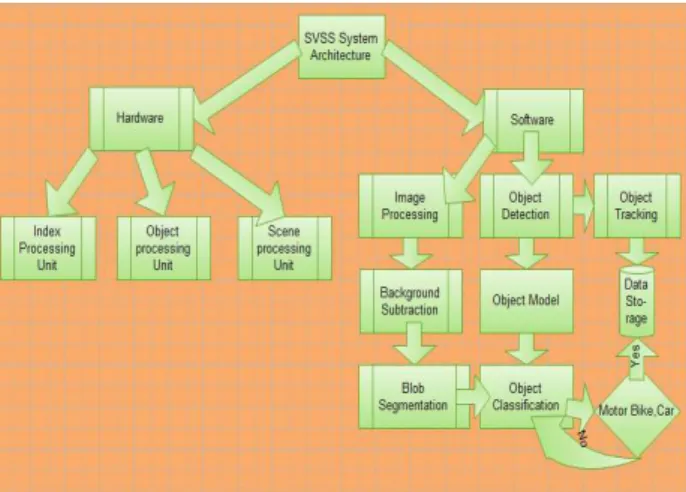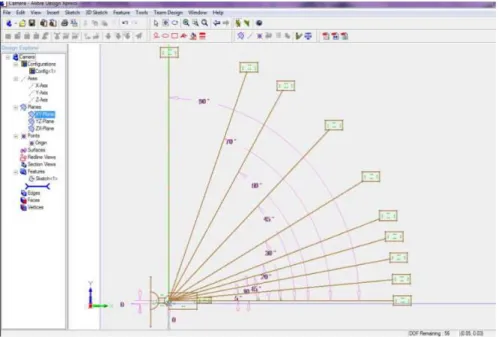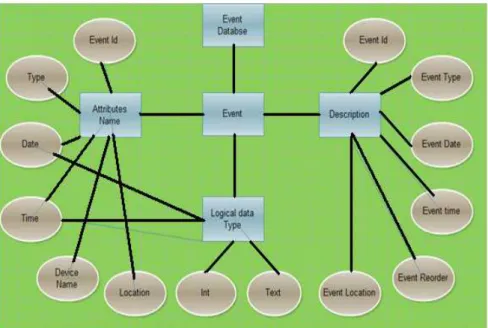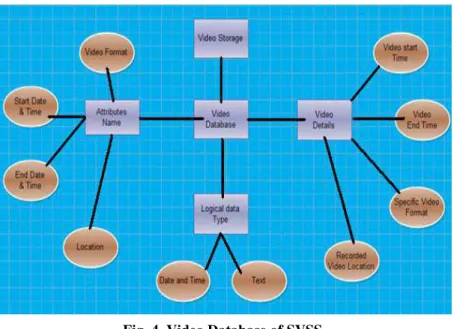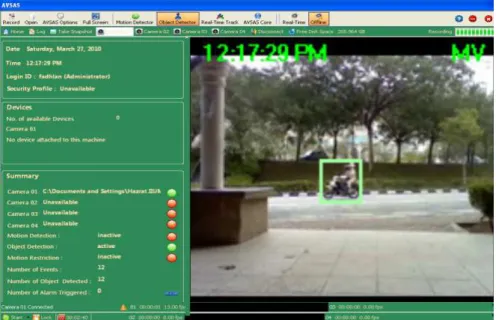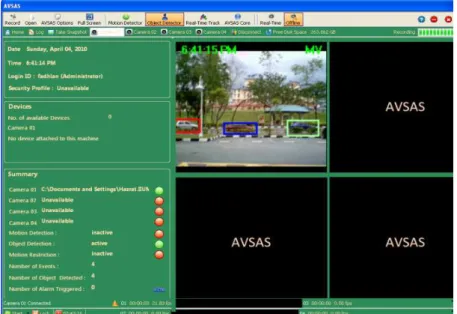SMART VIDEO SURVEILLANCE SYSTEM FOR VEHICLE
DETECTION AND TRAFFIC FLOW CONTROL
A. A. SHAFIE, M. H. ALI*, FADHLAN HAFIZ, ROSLIZAR M. ALI
Faculty of Engineering, International Islamic University Malaysia, P.O. Box 10, 50278, Kuala Lumpur, Malaysia
*Corresponding Author: hazratalidu07@yahoo.com
Abstract
Traffic signal light can be optimized using vehicle flow statistics obtained by Smart Video Surveillance Software (SVSS). This research focuses on efficient traffic control system by detecting and counting the vehicle numbers at various times and locations. At present, one of the biggest problems in the main city in any country is the traffic jam during office hour and office break hour. Sometimes it can be seen that the traffic signal green light is still ON even though there is no vehicle coming. Similarly, it is also observed that long queues of vehicles are waiting even though the road is empty due to traffic signal light selection without proper investigation on vehicle flow. This can be handled by adjusting the vehicle passing time implementing by our developed SVSS. A number of experiment results of vehicle flows are discussed in this research graphically in order to test the feasibility of the developed system. Finally, adoptive background model is proposed in SVSS in order to successfully detect target objects such as motor bike, car, bus, etc.
Keywords: Vehicle detection, Motion detection, Traffic density estimation, Traffic signal control.
1. Introduction
Abbreviations
BS Background subtraction ED Event database FAR False acceptance rate FRR False rejection rate
SVSS Smart video surveillance software TSR Total success rate
TV Threshold value VD Video database
flow prediction is achieved using time delay based neural networks [9]. In this paper, we will use image processing technique for identification of vehicles and traffic density by processing the traffic videos.
The pre-processing algorithm determines the contour of an object depending on the application. Once the object is detected and located, its boundary can be found by using edge detection and boundary following algorithms [10]. For object detection and recognition in video surveillance, various approaches have been proposed in the past years by many experts on this topic [11, 12].
Viitaniemi and Laaksonen [13] proposed a technique of moving object detection in video analysis. They considered all the test image segments given by a certain segmentation method. The segments have been ranked using the PicSOM framework according to their similarity of target object segments in the training images. They showed the average precision measurement for the test set object detection. Hampapur et al. [14] proposed the different approach, called salient motion detection, assumes that a scene will have many different types of motion, of which some types are of interest from a surveillance perspective.
2. System architecture of SVSS
Figure 1 shows the detail software design and system architecture ofSmart Video Surveillance Software (SVSS). It highlights the relationship unit among different hardware and software components.
2.1. Hardware selection
The hardware components required for the SVSS is shown in Table 1.
Table 1. Hardware Components of the SVSS.
2.2. Software selection
The minimum software requirements for this project are: • Windows XP
• Task Manager (Testing Tool Server) • C # Programming Language
2.3. Camera positioning
The test camera view angles are shown details in Fig. 2. The test parameters are selected based on our software optimization requirements. Selecting appropriate camera parameter is one of most important factors for successfully implementing the developed system.
Fig. 2. Camera View Angles are shown in Details from Different Positions.
Components Description Quantity
1. Outdoor Box Camera
1/3" Sony Super HAD, 380TVL /
0lx / 3.6 mm / 22IR LEDs / 12VDC 3
2. Dome Camera 1/3" Sony Super HAD 1
3. DVR Card 4 Channel 3rd Party DVR Card 1
4. Cable Lay coaxial cable 50 ft
5. DVR DVR card 1
2.4. SVSS Database
SVSS requires huge database storage in order to run the system smoothly. It is a collection of data for the surveillance system. SVSS classifies databases as a type of content, for example: bibliographic, full-text, numeric, and image. SVSS has two main types of database which are: (a) Event Database, (b) Video Database.
As both of the databases are important for the system, we have discussed more about these database systems and its relationship with the other functional components.
2.5. Event database
Figure 3 elaborates the Event Database (ED) and its attributes of SVSS while showing the inter-relationships with other functional components. ED shows that the Event is linked directly to the attributes and logical data type while describing the functional blocks.
Fig. 3. Description of an Event Database System of SVSS.
2.6. Video database
The Video Database (VD) is shown in Fig. 4. It highlights the video format, video start time and end time, date, video recording location, etc. The VD is stored in the video storage until a specified period selected by the user.
2.7. Video database
In this section, moving vehicle detection was carried out applying the existing Background Subtraction (BS) technique as well as our proposed and implemented Threshold Value (TV) adjusting technique. Thus, selected threshold values minimize noise effects. From various experiments carried out, the optimal threshold value is 25 as shown in Fig. 5. It can be observed that the image with Threshold Value (TV) 128 and 255 are darker than the previous image. Finally, image with TV 255 is completely dark due to increasing the TV up to the peak value. In case of camera pixel noise due to illumination changes, it was removed using opening filter. Small white pixels also have been removed in this process to smoothen the image. Finally motion boundary or blob indicator is used to detect the target objects.
Fig. 4. Video Database of SVSS.
2.8. Motorbike detection using blob segmentation technique
The image from edge filter is merged with the original image, producing image with edge around motion area. Then this edge will be changed to color channel. This is solely to emphasize the region where the motion actually occurs. Subsequently this will produce final image with colored blobs. Figure 6 shows the blob detected motor bike using our SVSS. The blob is marked by green color. Similarly if another object either motor bike or any other vehicle appears at under the camera surveillance it will be detected by another color indicating blob.
object. It is also noticeable that if the ratio falls under the range of 0.9<R<1.2 then it will be saved as motor bike. Similarly, if the ratio is between 0.3 and 0.6 then the detected object will be saved as car and if greater than 0.6 then it will be saved as bus.
Fig. 5. Impact of Threshold Values (TV), (a) Reference Image, (b) Gray Scale Image, (c) Image with TV=25. (d) Image with TV=128,
(e) Image with TV=250 and (f) Image with TV=255.
Table 2. Blob Analysis for Different Vehicles.
3. Results and Discussion
3.1. Vehicle detection in cloudy evening
Figure 7 shows the detected vehicle in the evening at about 6.42pm while it was cloudy environment. Table 3 gives detail results of the experiment. The testing videos were recorded at an angle of 10 degree while the position of the camera was 1.25 m from the ground. The targeted distance for the experiment was 2-30 m. We found the rate of false detection or false acceptance is 5.81% which shows the satisfactory result of the test case.
Table 3. Detection and Tracking Result at an Angle of 10 Degree.
Figure 8 highlights that the numbers of vehicles are decreasing with the increment of time. Using this data traffic signal light can be control efficiently at that place. The significant of the cloudy environment is to justify the accurate vehicle detection rate under this condition in order to implement practically. The special feature used in this case is the moving vehicle’s blob segmentation. The image from edge filter is merged with the original image, producing image with edge around motion area. Then this edge will be changed to color channel. This is solely to emphasize the region where the motion actually occurs. Subsequently this produces final image with colored blobs. The blob ratio has been calculated by counting the pixel of Height/Width of the image.
Fig. 8. Vehicle Flow at 06.41.15pm in a Cloudy Evening.
3.2. Vehicle detection in early morning
Fig. 9. Detected Bus at 07.14.25am in the Morning.
Table 4. Detection and Tracking Result at an Angle of 20 Degree at Various Times.
4. Performance Analysis of SVSS for Adaptive Background
In the developed SVSS adaptive background technique is used in vehicle detection purpose. In this technique we have moved the background frame slightly in the direction of the current frame. We have changed the colors of pixels in the background frame by one level per frame. In this process, the background is changed to the current image, pixels by pixels (1 level per frame). This process ensures that even smallest change with respect to the background in the image is detected successfully. To evaluate the system performance, three well-known measurements are used, False Rejection Rate (FRR), False Acceptance Rate (FAR), and Total Success Rate (TSR). The comparison of this method is illustrated in Table 5 which includes the performance evaluation based on computational efficiency measured from Average CPU Usage.
Table 5. Performance Analysis of Adoptive Background Model.
The above discussion and results can be summarized as follows. The most accurate result was found at an angle of 0 degree and 45 degree while camera height was 0.5 m and 6 m respectively. The nearest result was at 15 degree angle and 4 m height followed by 5 degree angle and 0.5 m height. On the other hand, majority of the false detections occurred at 70 degree and 60 degree angles and a height of 6 m from the ground. Besides this, there were false detections that occurred at night and in cloudy environment due to occlusion.
5. Traffic Control by Implementing SVSS
From the above results, we can easily find which road needs the efficient traffic system indicating the time period. Vehicle flow is also clearly viewed from the experimental results. Based on the results for the above test areas we can reset the traffic signal timing in order to achieve less waiting period in each junction. Thus, the developed SVSS is capable to optimize the traffic signal light successfully in any application environment.
6.Conclusion and Future Work
developed system is more efficient than the existing traditional surveillance system because it can detect the vehicle almost perfectly with a small rate of false acceptance and thus from the achieved result, traffic flow can be easily controlled.
Traffic flow control by SVSS in machine vision is the main contribution to the existing system. The following future works will enhance the system to solve the sophisticated security problems extensively:
• Night vision camera or infrared camera will help in recording the videos even at night or at dark place. Collision and damage detections are important areas that can benefit from such advance system.
• IP camera should be used to notify any danger or suspect acts to the user in real-time alert system.
• High camera resolution should be selected where very clear images are necessary. • Wireless camera should use in order to reduce wiring and maintenance cost.
References
1. Ji, X.; Wei, Z.; and Feng, Y. (2006). Effective vehicle detection techniques for traffic surveillance systems.Journal of Visual Communication and Image Representation, 17(3), 647-658.
2. Lozano, A.; Manfredi, G.; and Nieddu, L. (2009). An algorithm for the recognition of levels of congestion in road traffic problems.Mathematics and Computers in Simulation, 79(6), 1926-1934.
3. Zhou, J.; Gao, D.; and Zhang, D. (2007). Moving vehicle detection for automatic traffic monitoring. IEEE Transactions on Vehicle Technology, 56(1), 51-59.
4. Niu, X. (2006). A semi-automatic framework for highway extraction and vehicle detection based on a geometric deformable model.ISPRS Journal of Photography and Remote Sensing, 61(3-4), 170-186.
5. Zhang, W.; Fang, X.Z.; and Yang, X. (2006). Moving vehicles segmentation based on Bayesian framework for Gaussian motion model. Pattern Recognition Letters, 27(1), 956-967.
6. Li, X.; Liu, Z.Q.; and Leung, K.M. (2002). Detection of vehicles from traffic scenes using fuzzy integrals.Pattern Recognition, 35(4), 967-980.
7. Messai, N.; Thomas, P., T.; Lefebvre, D..; and Moudni, A.El. (2005). Neural networks for local monitoring of traffic magnetic sensors. Control Engineering Practice, 13(1), 67-80.
8. Srinivasan, D.; Choy, M.C.; and Cheu, R.L. (2006). Neural networks for real-time traffic signal control.IEEE Transactions on Intelligent Transportation Systems, 7(3), 261-272.
9. Baher, A.; Porwal, H.; and Recker, W. (1999). Short term freeway traffic flow prediction using genetically optimized time-delay-based neural networks. In Transportation Research Board 78 th Annual Meeting, Washington, D.C.
11. Yang, M.H.; Kriegman, D.J.; and Ahuja, N. (2002). Detecting faces in images: a survey. IEEE transactions on Pattern Analysis and Machine Intelligence (PAMI), 24(1), 34-58.
12. Hjelmas, E. (2001). Face detection: A survey. Computer Vision and Image Understanding, 83(3), 236-274.
13. Viitaniemi, V.; and Laaksonen, J. (2006). Techniques for still image scene classification and object detection. ICANN 2006,Lecture Notes in Computer Science, 4132, 35-44.
